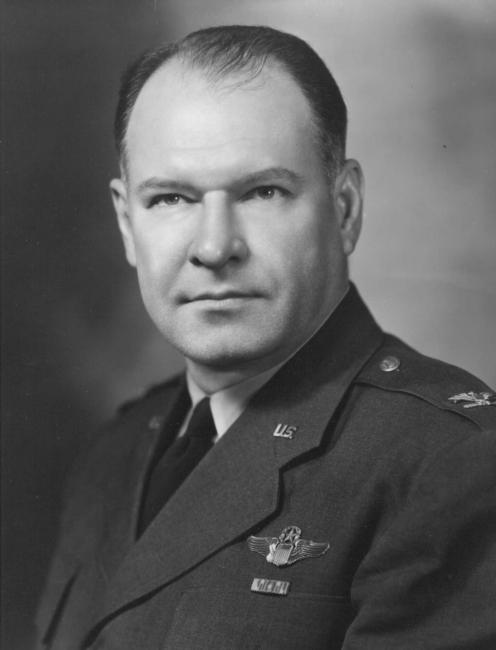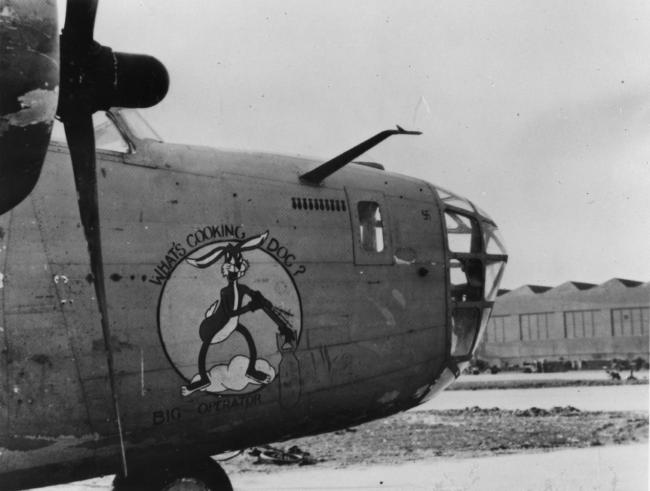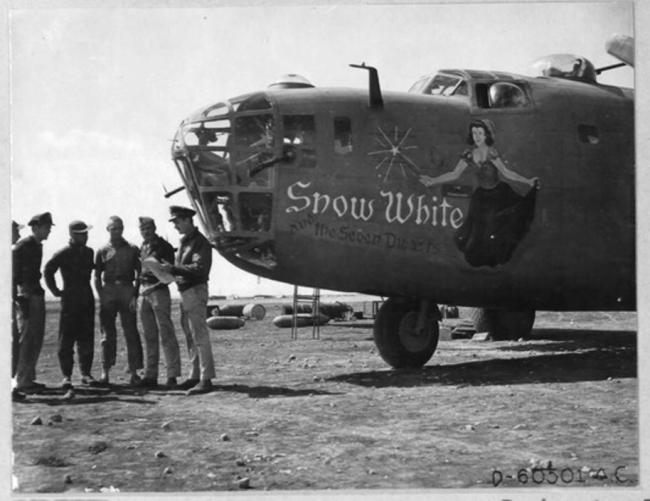Harold Francis Korger
Military
Removed associations not depicted in the image. Associated content should be added to the AIRCRAFT and/or PERSON records.
Object Number - UPL 33623 - Lieutenant Harold Korger in the 9th Air Force and the 98th Bomb Group. Flew as bombardier aboard the B-24D Liberator, Hail Columbia, flown by Group...
Lt. Harold Francis Korger was a B-24 bombardier in the 344th Bombardment Squadron, the 98th Bomb Group, and the 9th Air Force, based in Benghazi, Libya, 1943. He flew on the B-24D, Hail Columbia, with the Element Group Leader Col. John R. Kane, on the famous mission, Operation Tidal Wave, to destroy the oil refineries at Ploesti, Romania, and returned safely to base. 1 Aug 43.
Harold F. Korger was born October 7, 1918 to German American parents in Eau Claire, Wisconsin. He graduated from high school and attended the University of Wisconsin, earning a Bachelors Degree in Music in 1940. He would put that degree to use as the music director of the Eagle River Schools until World War II cut his teaching career short.
In December, 1941, Harry made a decision that would change his life forever. He enlisted in the U.S. Army Air Corps and graduated from Bombardier School at Midland, Texas, in 1942, and was commissioned a 2nd Lieutenant. He was stationed at various locations around the USA before transferring overseas in February, 1942, with the 9th Air Force, the 98th Bomb Group, known as, "The Pyramiders", and the 344th Bomb Squadron, stationed in Benghazi, Libya, North Africa. The 98th Bomb Group left the United States, July 15, 1942, flying their B-24s south to Florida, Brazil, and across the Atlantic Ocean, finally arriving in Tunisia, Egypt, and Palestine in July, 1942. They flew their first mission to Mersa Metruh on August 1, 1942. The 98th Bomb Group was initially assigned to the USMEAF (United States Middle East Air Force). However, the USMEAF was dissolved on November 12, 1942. At that time, the 98th came back under the command of the 9th Air Force. Harry Korger started flying combat missions with the 98th shortly after he arrived in North Africa, mostly bombing targets in Italy. He had 23 missions and almost 300 hours of flying time in his log book when the mission that would define his later military career was announced. It was the mission to attack and bomb the oil refineries at Ploesti Romania. 1 Aug 1943.
Harry was hand picked by Col. John R. “Killer” Kane, to be his bombardier for the Ploesti mission. Col. Kane was to earn the Medal of Honor for his leadership and valor, flying, Hail Columbia, as Group Commander on the mission.
On the Morning of August 1, 1943 the crew of, Hail Columbia, took off from Lete, their airbase at Benghazi, Libya. In letters that Harry wrote home, he proudly wrote that he was going to fly on the Ploesti mission with Group Leader Colonel John R. Kane, a former West Point, All American football player. After the mission, Korger sadly wrote, "I saw my old friends crash to a flaming death before my eyes. The Jerries were throwing up everything they had at us. Our plane was shot to shreds but, by sheer flying skill, Colonel Kane got us out safe. My bombs hit dead center on my target, the Astra Romano refinery, and we wiped the place out. Then, the fighters jumped us, and more of our friends were shot down. But they took, at least, four or five German and Romanian fighters down with them for every one of us. Once the bombs were dropped, and after a long harrowing flight over Turkey to, safety and freedom, Harry Korger and, Hail Columbia, reached the friendly British airfield at Nicosia, Cyprus. Lieutenant Korger related, "John Kane crash landed, Hail Columbia, in the dark, after hitting a ditch the British had dug across the their runway's threshold at Cyprus. The two pilots and Lt. Korger, were surprised to see their main landing gear assemblies go cartwheeling past them on both sides of the airplane after they hit the ditch across the runway. Everyone survived the mission and the crash landing, thanks to the skills of both Col. Kane, and his copilot, Johnny Young, along with Bombardier Lt. Korger, and their excellent lead navigator, Lt. Norman Whalen, and, of course, the rest of their cracker jack crew of gunners, who defended their airplane with great skill, determination, and extreme valor.
Capt. Korger was awarded another Oak Leaf Cluster to his Distinguished Flying Cross, for his service and valor on the mission, as did all of the men who flew on the mission. The following day, the crew spent the day looking over their shot up and wrecked B-24 bomber, Hail Columbia, with over 150 counted holes the airplane, marvelling at the damage and the number of the flak splinter and cannon shell holes in it, each wondering how it was possible no one on board was killed or even seriously wounded. But, this mission and this airplane would not be the only ones Lt. Korger would fly on, that would be destroyed. Over his long career in the Air Force, he would get another ride in another one a month later.
After the Ploesti mission, Lt. Korger was given the option of flying home and going on a war bond tour with Lt. John Young and all of his crewmen from Young's former B-24D, Kickapoo, that had crashed on takeoff for the Ploesti mission, killing most of it's replacement crew. But Harry decided he should finish his last required mission. It was a decision he would later regret. On September 3, 1943, Lt. Korger would fly on what he thought would be his last mission, his 25th, before going home to his beloved wife, Bernice. His final mission in the MTO was supposed to be a routine one, over Sulmona, Italy. But, there were no easy missions at that time in the war. On the way to their target, Korger's assigned B-24D, What's Up Doc ?, was attacked by German JU-88 fighter-bombers and ME-110 fighters equipped with cannons and air to air rockets. What's Up Doc?, quickly took several direct and devastating hits. It pitched over into a dive, fell into a flat spin, and crashed. Harry successfully bailed out and earned the first of his career "Caterpillar Club" pins. Harry hit the ground hard and was injured, but survived. He was found and arrested by the Italian police and held in several German and Italian prison camps for the next two years, 1943 to 1945. Four of, What's Up Doc ?'s, crewmen were killed. 6 POW. 4 KIA. 3 Sep 1943.
As a WWII POW, Harry Korger was part of the Stalag Luft I prison camp (musical) band led by Mike Spodar that was known to the Kriegies (Germans) as the "Round the Benders". "Around the Bend" was a Kriegie term, which means that one is mentally off key - the inevitable result of chronic "barbed wire fever". The band has been described as "a first class outfit". They gave the POWs many happy hours on their instruments that were provided by the YMCA. Members' names and hometowns were noted on a drawing by POW artist Don H. Ross.
In the years between WWII and his retirement in 1971, Harold Korger never again saw combat. But that didn’t mean he didn’t risk his life.
On Feb 16, 1956, he was the navigator of the first B-52 to be lost by the USAF, on a mission near Tracy, CA. His airplane caught on fire after an alternator failed and exploded, allowing Harry to earn his 2nd Caterpillar Club pin, when he ejected from the B-52 at 36,000 feet, breaking an arm. He and 3 other crewmen survived the bail out. But 4 of them did not. 1 WIA-RTS. 4 KIA. 16 Feb 1956.
After a long and successful career, Harold Korger retired from the USAF in 1971 with the final rank of Colonel. He eventually settled in Medford, Oregon, where he lived with his wife, Bernice, and family, until he died in 1995 at the age of 77.
For his long career of service in the U.S Army Air Force, in WWII, and the later, newly organized, U.S. Air Force, Col. Korger was awarded the following decorations : The Distinguished Flying Cross with one Oak Leaf Cluster, the Air Medal with 5 Oak Leaf Clusters, the Purple Heart (twice), the Meritorious Service Medal, the Air Force Commendation Medal, the Joint Services Commendation Medal, the European-African-Middle Eastern Campaign Medal, the Prisoner of War Medal, WWII Victory Medal, and the Distinguished Service Medal.
Connections
See how this entry relates to other items in the archive by exploring the connections below.
Units served with

- Unit Hierarchy: Squadron
- Air Force: Ninth Air Force
- Type Category: Bombardment

- Unit Hierarchy: Group
- Air Force: Ninth Air Force
- Type Category: Bombardment
People

- Military/Civilian/Mascot: Military
- Nationality: American
- Unit: 98th Bomb Group 344th Bomb Squadron
- Highest Rank: Staff Sergeant
- Role/Job: Waist Gunner

- Military/Civilian/Mascot: Military
- Nationality: American
- Unit: 389th Bomb Group 564th Bomb Squadron
- Service Numbers: 37038892 / O-740807
- Highest Rank: Second Lieutenant
- Role/Job: Co-Pilot

- Military/Civilian/Mascot: Military
- Nationality: American
- Unit: 98th Bomb Group 344th Bomb Squadron
- Highest Rank: First Lieutenant
- Role/Job: Radio Operator

- Military/Civilian/Mascot: Military
- Nationality: American
- Unit: 389th Bomb Group 564th Bomb Squadron
- Service Numbers: O-666292
- Highest Rank: Second Lieutenant
- Role/Job: Pilot

- Military/Civilian/Mascot: Military
- Nationality: American
- Unit: 98th Bomb Group 344th Bomb Squadron
- Service Numbers: O-29680
- Highest Rank: Colonel
- Role/Job: Commanding Officer / Pilot
Aircraft

- Aircraft Type: B-24 Liberator
- Nicknames: - Kickapoo
- Unit: 98th Bomb Group 344th Bomb Squadron

- Aircraft Type: B-24 Liberator
- Nicknames: - Raunchy
- Unit: 98th Bomb Group 344th Bomb Squadron

- Aircraft Type: B-24 Liberator
- Nicknames: - Hail Columbia - Little Chief Big Dog - Grumpy
- Unit: 376th Bomb Group 98th Bomb Group 344th Bomb Squadron

- Aircraft Type: B-24 Liberator
- Nicknames: - What's Cooking Doc? - Big Operator
- Unit: 98th Bomb Group 344th Bomb Squadron

- Aircraft Type: B-24 Liberator
- Nicknames: - The Vulgar Virgin - Hell From Heaven - Shoot Youre Faded
- Unit: 98th Bomb Group 344th Bomb Squadron
Missions

- Date: 1 August 1943
- Official Description:
Places

- Site type: Airfield
Events
| Event | Location | Date | Description |
|---|---|---|---|
|
Born |
Eau Claire, WI | 7 October 1918 | Son of Anton Friederich and Rose M Korger. |
|
Enlisted |
Wausau, WI | 18 December 1941 | Wausau, Wisconsin |
|
Based |
Berca | 15 July 1942 - 3 September 1943 | Assigned to the 344th Bomb Squadron, the 98th Bomb Group, The Pyramiders, in the 9th Air Force, USAAF. |
|
Other Prisoner of War (POW) |
Barth, Germany | 3 September 1943 | Prisoner of War (POW). Stalag Luft I. |
|
Died |
Medford, OR | 19 October 1995 | |
|
Buried |
Eagle Point National CemeteryEagle Point, Jackson County, OR | 22 October 1995 | Eagle Point National Cemetery Eagle Point, Jackson County, Oregon |
Revisions
Minor detail and wording changes for accuracy. - Kickapoo - Find-A-Grave, database and images (https://www.findagrave.com/memorial/886863/harold-francis-korger: accessed 12 February 2023), memorial page for Col Harold Francis Korger (7 Oct 1918–19 Oct 1995), Find a Grave Memorial ID 886863, citing Eagle Point National Cemetery, Eagle Point, Jackson County, Oregon, USA; Maintained by B24CoPilotNiece (contributor 47391745). - Kickapoo
American Air Museum In Britain - Harold Francis Korger - Kickapoo
TogetherWeServesd.com Black Sunday - Michael Hill Into the Fire - Duane Schults
TogetherWeServesd.com Black Sunday - Michael Hill Into the Fire - Duane Schults
FindaGrave Memorial ---- Black Sunday - Michael Hill ---- The Return Of Hadley's Harem - Michael Schultz








